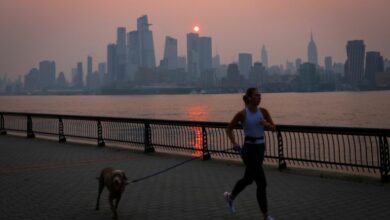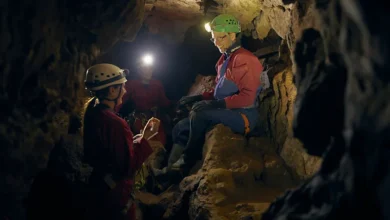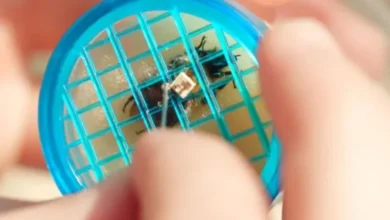‘I had no idea it would snowball this far’: Why a Brazilian favela facing eviction decided to go green
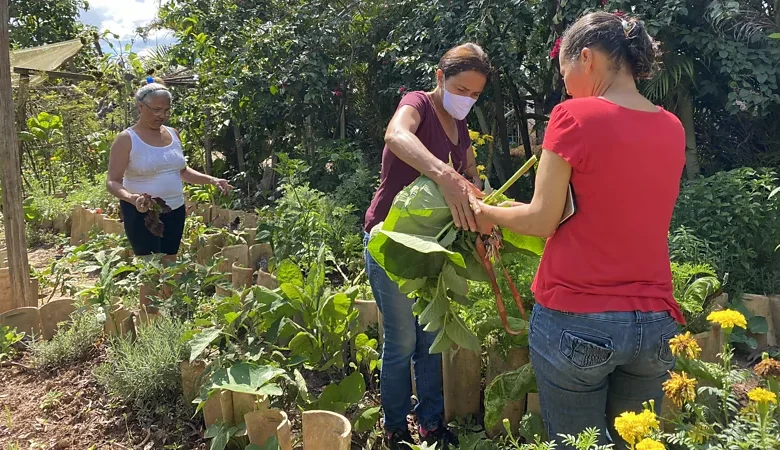
In Brazil’s crowded favelas, green space is hard to come by, but this São Paulo community is showing how more sustainable favelas can give back to their residents.
“You have to remove the seeds before they flower.”
Maria de Lourdes Andrade Silva is showing me how she picks the buds off a flowering basil plant as she tends to a vibrant community garden in a favela in São Paulo, Brazil – South America’s largest city. “If you leave it to flower, it’ll use up all its energy and it will die,” she says.
When I visited this 0.5 hectare (1.2 acre) garden in Vila Nova Esperança favela in 2022, it was teeming with herbs, plants, vegetables and life. Today, it’s been Silva’s labour of love for more than a decade. Before Silva’s efforts, it was entirely different: the disused space on the edge of the favela was piled high with rubbish and people would come here to dump things, she says.
Originally from Itaberaba, Bahia in the north-east of Brazil, Silva – better known as LiaEsperança, or Lia “Hope” – moved to the favela in 2003 having never lived in one before.
Home to more than 8% of Brazil’s population, favelas – or Brazilian slums – are widespread informal settlements often situated on the periphery of major cities such as São Paulo and Rio de Janeiro. They are home to low-income populations and can be built precariously on unstable land such as slopes and hills. They are often underserved in formal infrastructure – meaning they can be especially vulnerable to climate impacts and risks such as landslides – and commonly don’t have access to public services such as sanitation.
We didn’t have sustainability specialists to teach us how to preserve the environment, so we came up with the idea of creating a community garden – Maria de Lourdes Andrade Silva
In 2006, Silva, who was working as a florist in São Paulo, learned there was a process in place to remove the families living in the favela. The community is located near – and what São Paulo’s Public Prosecutor’s Office considered within – an environmental protection area. Because of the litter and lack of sanitation services, the settlement directly impacted the local environment, so the prosecutor wanted to remove the settlement and the litter, restore and promote reforestation of the area, and incorporate it into the nearby Jequitibá Park. It meant 600 families in the favela faced eviction.
“I thought, ‘I have to do something to not lose my home nor anybody else’s,'” says Silva.
Along with other members of the community, she set out to clean up the area and prove in the process that favela residents could benefit their local environment.
Igniting change
Silva guides me through the garden, ducking under giant passionfruit vines and past uniform rows of seedlings. “Before, the community was completely full of rubbish,” she says. City waste collection didn’t reach this informal settlement, so in 2006 she instigated a community clean-up which became a regular collective effort. The community also built a waste bin shelter to dispose of waste across the whole favela.
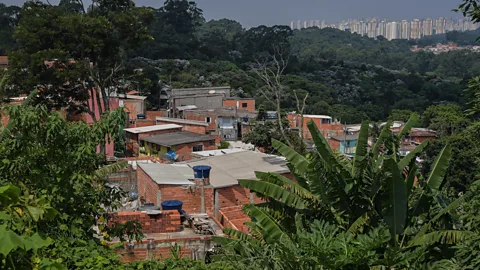
Silva argues that people don’t intend to degrade the environment but do it because they don’t know any different or lack access to necessary waste collection services.
In 2013, at a community meeting with over 200 residents a year after a court had ruled against a civil public action to evict the community, Silva warned that they still needed to find a way to coexist with the natural environment or face being forced from their homes. “We didn’t have sustainability specialists to teach us how to preserve the environment, so we came up with the idea of creating a community garden,” says Silva. “And with the garden, we would bring environmental education.”
“I thought it was a great idea,” says Cícera Maria Lino, a resident of Vila Nova Esperança who joined the efforts against eviction and has volunteered at the community garden since its beginnings. She grew up growing vegetables in the countryside of Pernambuco in the north-east of Brazil and moved to the favela in 2002. “It was a big fight [against eviction], and we didn’t have energy at the time. But we got it with Lia.”
84% of favela dwellings in São Paulo have no open space surrounding them at all
Not everyone was immediately onboard with the garden project, however. Some residents felt the land should be used to build more houses or sold to bring in money to the community, locals tell me. Ultimately, though, when the community held a vote, the majority were in favour of the garden, they say.
At the beginning, some five or six residents started planting vegetables. “I started out of necessity,” says Silva. “I had no idea it would snowball this far.” The community began contacting NGOs and universities to help them build a sustainable community.
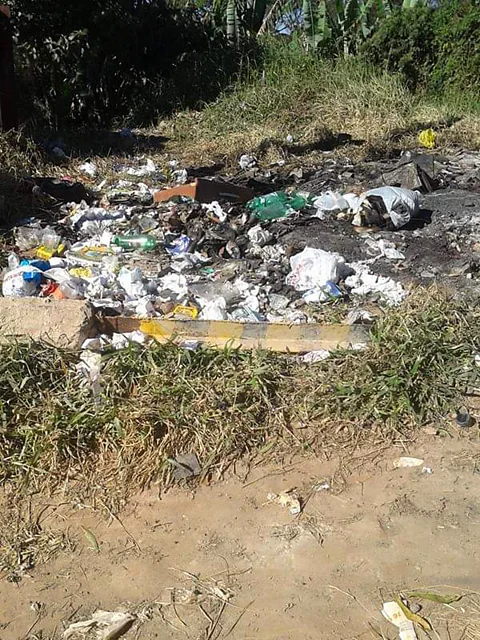
When Batista Santos, a security guard originally from Bahia, moved to Vila Nova Esperança from a neighbouring community in 2014, he heard about the project but didn’t immediately get involved. “I was working 12-hour days… and working in the garden is hard work,” he says. It wasn’t until the pandemic hit in 2020 and he became unemployed that he started to participate and realised the value of the garden, he says. “The space today is marvellous and beautiful… It’s really changed my life.”
Now Santos is vice president of Vila Nova Esperança’s resident’s association, which organises meetings and tries to address issues to improve the community (Silva has been the association’s president since 2010, after leading the community’s fight against eviction).
The battle for space
Gardens like these are a rarity in Brazil’s slums. Favela populations are growing, with nearly five million more people living in them in 2022 compared with 2010, a rise driven by a lack of affordable housing in Brazil’s large cities, low wages and rapid urbanisation as people move to the cities in search of jobs and opportunities.
As favelas grow, they not only expand and encroach on (often protected) land, but their population density increases, meaning already highly populated areas become even more crowded. The population density of favelas in São Paulo is four times that of the formal city.
As informal settlements expand, it’s hard to keep any space vacant in these areas – let alone green space, explains Alexandra Aguiar Pedro, a São Paulo-based urban planner who conducted research on creating urban gardens in favelas in 2020 while working for the housing secretariat of São Paulo City Hall.
If people have gardens that are providing food, then they are able to feed themselves – Theresa Williamson
In fact, 84% of favela dwellings in São Paulo have no open space surrounding them at all, a 2016 study found. Because they are built and expanded informally, says Pedro, there is rarely – if ever – planning to integrate green or open spaces. Just one type of recreational space is common in favelas: “When you look in these areas, the only empty spaces are the soccer fields,” says Pedro.
Space needs to have value to residents if it is to resist these expansion pressures, says Wolfgang Wende, a researcher in landscape, ecosystems and biodiversity at the Leibniz Institute of Ecological Urban and Regional Development in Germany. “The only way to do that is to create a kind of sense of ownership by the neighbourhood, so that they really feel responsible for these open spaces.”
A prize-winning transformation
“Favela upgrading” is the Brazilian government’s attempt to integrate favelas into the formal city with public services and infrastructure and formalise land registration. Butcritics say these attempts can end up doing little to alleviate persistent issues of poverty that push people into favelas in the first place. “Only the initiatives which involve local people work,” says Pedro.
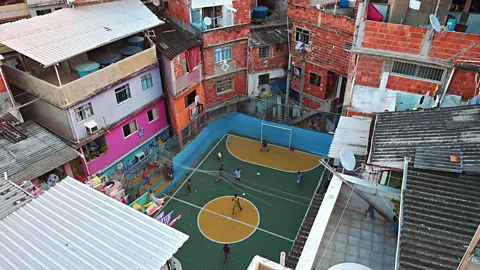
Silva says Vila Nova Esperança’s greening project has succeeded due to the involvement of the entire community. Too often, she says, the government arrives with engineers, architects and a top-down approach that doesn’t involve the local community. “People need to have a voice.”
However, responding to these criticisms, Guilherme Simões, the Brazil’s national secretary of urban peripheries says it is essential that governments invest in urban infrastructure, calling it “a fundamental condition for access to decent housing, basic sanitation and other social rights”. Public participation, he agrees, is fundamental to ensuring that such interventions are successful, and he points to the Brazilian government’s (Periphery Life programme), which includes a participatory action plan as a mandatory element for such interventions.
Vila Nova Esperança’s project has received recognition across Brazil and globally. In 2014 it was awarded the Milton Santos prize for social development by the municipality of São Paulo. Following this recognition, much of the community has now been given formal water, sewerage and electricity connection and asphalt roads.
Still, a battle against eviction in the community has been ongoing for several years. In 2011, things came to a head when armed men showed up to forcibly remove families, although it is not clear who they were working on behalf of. The residents resisted, although over 100 families agreed to leave following the ordeal. But most Vila Nova Esperança residents remained and in 2012, a judge ruled in their favour and determined they could stay.
Motivated by this ruling, they moved forward with the garden and in 2013 began cultivating carrots, lettuce, beetroot and dozens of other fresh vegetables, fruits and herbs. Anyone is welcome to volunteer, receiving harvested food in return. The remainder is sold at an affordable price to other residents.
Gardens like these offer communities “food sovereignty”, says Theresa Williamson, an urban planner and executive director of Catalytic Communities, a non-profit that manages the Sustainable Favela Network in Rio de Janeiro. “If people have gardens that are providing food, then they are able to feed themselves.”
Santos says the garden has made a difference to him and his family. “To this day, the garden helps a lot of families here,” he says.
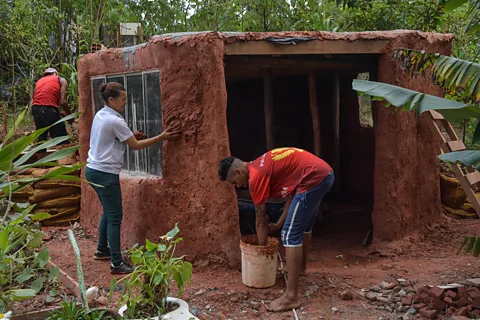
Following the garden’s success, the community moved forward with their next undertaking – a library. They used a simple traditional wattle and daub method from the north-east of Brazil to construct the library, sourcing recycled wood and materials wherever they could and only buying new supplies when strictly necessary. “That was our first sustainable construction,” says Silva.
A community kitchen followed in 2018 and they began teaching people to prepareplantas alimentícias não convencionais (non-conventional edible plants, often referred to as “pancs“). These are Brazilian fruits, leaves and flowers with high nutritional value that grow easily in small spaces, such as lambari (also known as the goldfish plant) and sweet potato plant leaves.
Pancs offer exciting potential for communities with limited space, says Williamson. “They just freely grow and you can grow them in your windowsill.”
With the kitchen came entrepreneurship. Community members began to make and sell cakes as well as “marmitas” – hot lunch deliveries, a staple in Brazil – which brought in income.
“We brought food security, we taught people to eat healthy food, [and] we reduced the number of visits to the hospital, because we have a lot of medicinal plants,” says Silva, explaining how the community uses plants to help to treat fevers and flu.
Today, the government offers employment opportunities at the community garden through the Agriculture Work Operation Programme, which seeks to expand urban agriculture – a stark contrast from the attempted evictions over the past two decades. The community kitchen provides healthy weekday meals to more than 200 families using food from the garden, and the community space hosts skills workshops and courses such as sewing and crochet. Women attending these workshops tell me they hope to earn an income using these skills once they complete their courses.
A bottom-up approach
Most of the volunteers in the garden and kitchen are women, and the initiative has also provided them with a safe space, says Silva.
“You get these ripple effects that are really strong when the community gardens are run collectively by women,” says Williamson, who has worked with women-led gardening collectives in Rio de Janeiro favelas. Women support each other and share knowledge on employment, household issues and how to raise their children, she says.
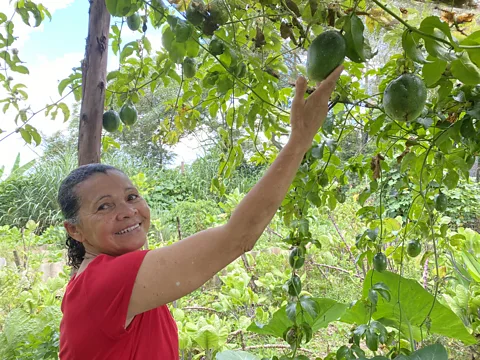
All the volunteers I spoke to when visiting the favela in 2022 told me that tending to the garden benefits their psychology, health and mental health. “I always like to come here. I come whenever I can,” Lino told me.
In order to share their knowledge further and assist other communities, in 2018 Silva set up the Lia Esperança Institute to share knowledge. She has also travelled the country sharing her lessons and learnings with other communities, favelas, schools and universities. One group she met with is Mulheres do GAU (Women of the Urban Agriculture Group), a collective of women who have moved from the north-east of Brazil to the east of São Paulo, where they run a community garden and kitchen at a nursery school.
The emissions from travel it took to report this story were 5kg CO2, as Lottie was in Brazil for other reasons. The digital emissions from this story are an estimated 1.2g to 3.6g CO2 per page view.
Today, despite the favourable 2012 ruling, the community still fear eviction. Further attempts persuaded more families to leave in 2022, says Silva.
“The fear, the insecurity, is constant and we have no guarantee of anything,” says Santos. “But we’re living in a space that we’re taking good care of and preserving [the environment].”
A spokesperson from São Paulo’s public ministry of state (MPSP) said that the case is currently in the sentence enforcement phase and it has held meetings with residents and relevant public agencies, especially housing association CDHU which MPSD says is “adamant and wants residents to move to housing complexes by them built [elsewhere]”. It added that it is trying to keep the families in place but that this depends on the goodwill of the CDHU. However, it adds that “there can be no increase in occupation, as this is an environmental preservation area”.
The CDHU, however, said that the removal of families from the community is the result of a final court decision which followed the opinion of the MPSP, noting it has complied with the court decision and intends to continue with the agreement in recent petitions to remove the families and reforest the area.
While no mention was made of the favela cleaning effort in the 2012 ruling, it was highlighted by councillors fighting for their case. Lino believes the garden is a key reason the community remains. “If it wasn’t for the garden, they would have been able to get us out of here,” she says. “The work that Lia has done has had a huge impact. There are people living here who don’t value [the work that Silva has done] but they have no idea how good it has been for us all.”
Silva’s part, though, she says it is the power of community she has learned through the project. “I can’t do it alone,” she says.


